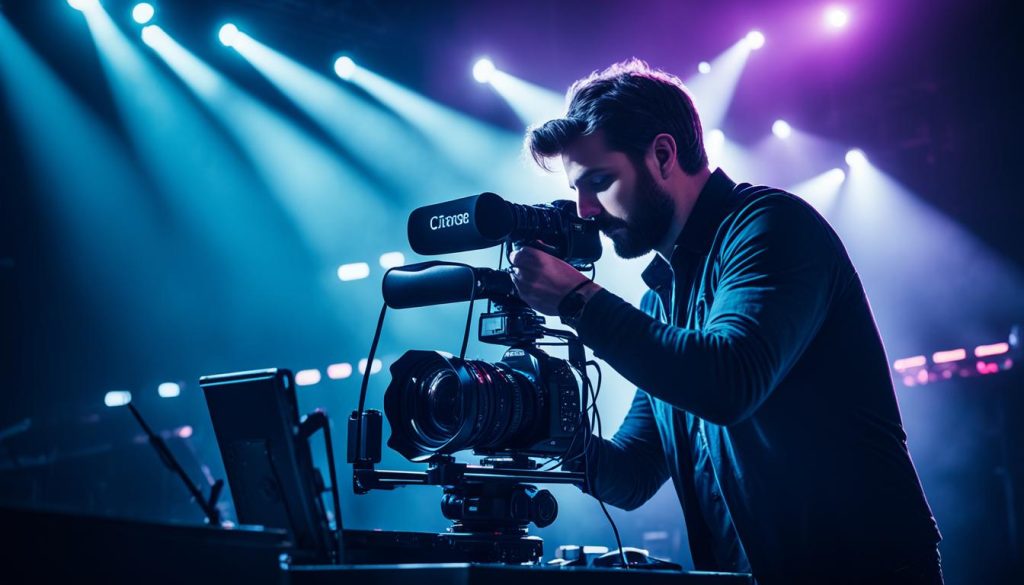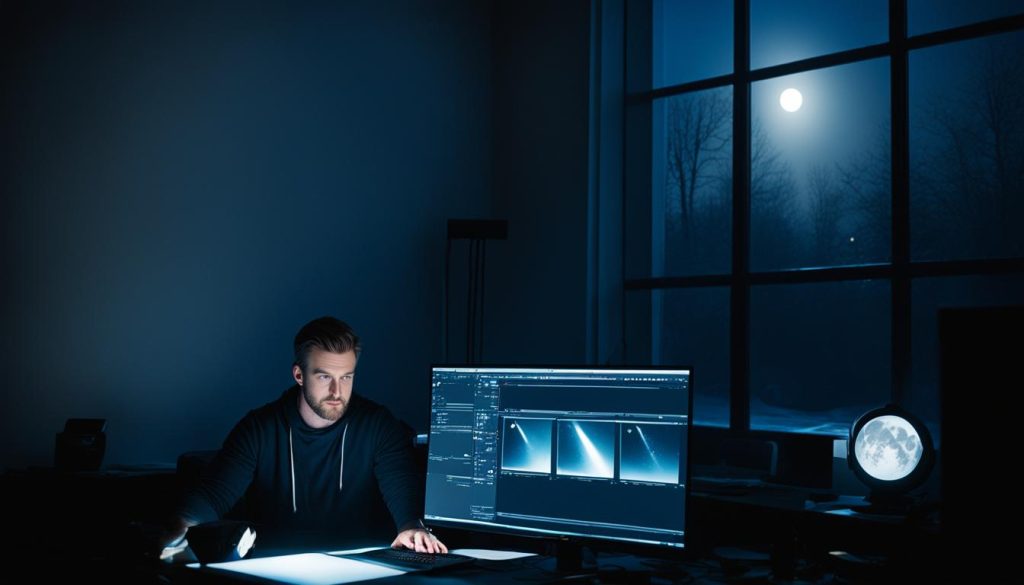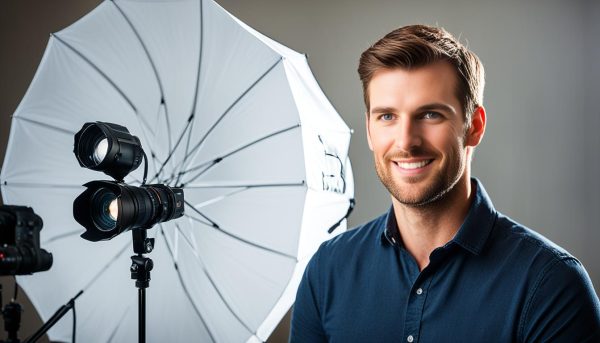Embarking on the path of event photography can lead to a world where shadows and highlights play significant roles in the story you’re capturing. Low light photography techniques are essential skills that transform these challenges into an opportunity to produce truly stunning imagery. It’s not just about having the best cameras for low light photography; it’s also about how you handle those decisive moments and manipulate the available light to your advantage.
Whether it’s the soft glow of candlelit receptions or the vibrant pulse of an evening concert, grasping the nuances of low light photography is key to delivering images that resonate with vibrancy and detail. In this segment, we’ll explore the art of capturing the essence of events even when the lighting is not ideal. We’ll also provide helpful low light photo editing tips to ensure your work stands out with clarity and impact.
Key Takeaways
- Understanding and overcoming the inherent challenges of low light in event photography.
- Improving technique with proven low light photography strategies.
- Choosing cameras and equipment best suited for low light scenarios.
- Applying critical editing techniques to enhance low light images post-event.
- Developing a keen eye for capturing the mood and atmosphere unique to low light events.
Understanding Low Light Photography Challenges
Delving into low light photography challenges, it becomes apparent that capturing high-quality images in dim conditions is a test of skill and understanding. One core challenge that photographers face is the scarcity of ambient light, which is pivotal for detail and depth in images. To exacerbate the issue, high noise levels become a common adversary, particularly when trying to compensate for low light by adjusting the camera’s sensitivity or ISO. Another formidable foe is motion blur, where even minor movements can lead to less than sharp images. However, equipped with the right event photography lighting tips, these obstacles can be rendered surmountable, leading to captivating, clear photographs even in the darkest of venues.
The following table outlines some practical event photography lighting tips to help overcome common low light photography challenges:
| Challenge | Impact on Photography | Lighting Tip |
|---|---|---|
| Limited Ambient Light | Can result in underexposed images lacking detail and color vibrancy. | Use a fast lens with a wide aperture to allow more light to hit the sensor. |
| High Noise Levels | Noise can detract from the image clarity, making it look grainy or pixelated. | Opt for cameras with larger sensors that perform better in low light and keep ISO as low as possible. |
| Potential Motion Blur | Any movement can cause the subject or background to become blurred, ruining the shot. | Stabilize your camera with a tripod or monopod to reduce the chance of camera shake. |
By recognizing these low light photography challenges and implementing these tips, photographers can navigate through dimly lit events with confidence. It’s not just about battling unfavorable conditions but leveraging them to create stunning, ethereal images that resonate with a unique visual appeal.
Mastering Camera Settings for Low Light Conditions

When the lights dim and the ambiance of your event relies on soft glows and shadows, knowing the intricacies of your camera’s settings is crucial. Professional photography under these circumstances is not just about relying on equipment; it’s about understanding and adjusting the tools at your disposal. Below, we delve into the technicalities of camera settings for low light conditions, focusing on ISO, aperture, and shutter speed to enhance your event photography portfolio.
Choosing the Right ISO for Ambient Lighting
ISO measures the sensitivity of your camera’s sensor to light. A higher ISO setting can be a lifesaver in dim settings, capturing images that would otherwise be underexposed. Nonetheless, it’s a delicate balance, as a higher ISO may introduce unwanted grain or noise. Let’s explore how choosing the right ISO for ambient lighting can make a considerable difference in the quality of your images.
Aperture Settings to Maximize Light Entry
The size of your lens’ aperture affects the amount of light that hits the camera sensor. In low light, a wider aperture, denoted by a smaller f-number, is your ally. By aperture settings to maximize light entry, you can dramatically improve exposure without necessitating significant ISO boosts, thus maintaining image quality.
Shutter Speed Adjustments to Prevent Blur
Sometimes, to get a well-exposed shot in low light, we might reduce the shutter speed—keeping the shutter open longer to let in more light. However, there’s risk attached: longer exposure times make photos susceptible to blur from hand-shake or subject movement. It’s paramount that photographers make shutter speed adjustments to prevent blur, which could involve using a tripod or increasing ISO as a trade-off for a faster shutter speed.
Here’s a comparison of settings that can be a starting point for photographers looking to capture vibrant and sharp images in low light scenarios:
| Scenario | Recommended ISO | Aperture | Shutter Speed |
|---|---|---|---|
| Indoor Event with Ambient Light | 800-1600 | f/2.8 – f/4 | 1/60 – 1/125 sec |
| Outdoor Night Event | 1600-3200 | f/2.8 or wider | 1/30 – 1/60 sec |
| Concert with Dynamic Lighting | 2000-4000+ | f/2.8 or wider | 1/125 – 1/250 sec |
Practice is the best way to learn how these settings interact with one another. Start with the suggestions above but don’t be afraid to tweak them to find the sweet spot for your particular situation. And remember, the ultimate goal is to capture the moment as truly and vibrantly as it felt, all the while maintaining the integrity of your image quality.
Event Photography Tips Low Light
Delving deeper into the realm of event photography under challenging lighting, we come across several pivotal techniques that enable photographers to capture the essence of the event, regardless of the setting’s darkness. While having gone through the essentials of camera settings for low light, we now turn our attention to the practical strategies that can transform your low-light captures into mesmerizing memories.
Selecting the Proper Lens for Dark Environments
Understanding the significance of selecting the proper lens for dark environments is crucial. Prime lenses with wide apertures, such as f/1.4 or f/1.8, allow more light to hit the sensor, making them the ideal choice for photographing in poorly lit conditions. The selection process involves considering the lens’s low-light capabilities alongside its focal length, which should align with the event’s spatial dynamics and the desired composition of your shots.
Utilizing Manual Focus Over Autofocus in Low Light
Given the unreliable nature of autofocus in dim settings, utilizing manual focus over autofocus in low light is often the preferable route. Manual focus puts you in control, allowing for precise adjustments that autofocus may miss in the absence of adequate contrast. Patience and practice in honing this skill will lead to sharper, more defined images, even in the subtle glow of ambient lighting.
Creative Use of Available Light Sources
Finally, the creative use of available light sources shapes the aesthetic quality of your low-light imagery. Whether it’s the intimate glow of candlelight tables or the dynamic patterns cast by a neon sign, these elements can be artfully incorporated into your photography to create compelling shots. Positioning subjects relative to these lights and even using them to silhouette figures or emphasize contours can add a dramatic flair to your event photos.
Post-Processing Low Light Photos for Clarity and Detail

The art of photography doesn’t end when the shutter closes; especially with low light photography where each shot might harbor hidden depths waiting to be revealed. With the right low light photo editing tips, your images can transition from murky to mesmerizing. Post-processing is essential to enhance your images for maximum clarity and detail.
Editing low light photos usually involves several stages, each with its own purpose. Begin with noise reduction to clean up the grain that often plagues photos taken in dark environments. Be subtle with noise reduction to avoid smudging details.
Next, adjust the exposure. Low light images may be underexposed; using editing software, you can brighten these images, bringing out details that were lost in the shadows. However, take care not to over-expose highlights which may become irreparably blown out.
Color enhancement is another crucial step. Low light conditions can result in muted or inaccurate colors; vibrant tones can be restored through careful color correction. A keen eye for color balance will ensure skin tones remain natural and the mood of the scene is preserved.
Here are some specific low light photo editing tips to bear in mind:
- Use a calibrated monitor to ensure color accuracy when editing.
- Apply selective adjustments using masks or layers to avoid global changes that affect areas which do not require editing.
- Sharpen your photos slightly to recapture some of the definition that might have been lost due to camera shake or high ISO settings.
Consider the following table for a clear understanding of the effect each editing tool has on your low light images:
| Editing Tool | Purpose | Effect on Low Light Image |
|---|---|---|
| Noise Reduction | To minimize the grainy texture | Creates a cleaner image, but can reduce detail if overused |
| Exposure Adjustment | To correct the overall brightness | Can reveal hidden details in shadows without affecting highlights |
| Color Correction | To fix color casts and enhance saturation | Brings back the vibrancy and mood of the scene |
| Sharpening | To increase image definition | Improves clarity but should be used sparingly to avoid adding noise |
For the best results, shoot in RAW format to ensure you have the most data to work with during post-processing. Apply these low light photo editing tips to bring out the striking details of your work, transforming a potentially average shot into a remarkable showcase of your photography skills.
Conclusion
Navigating the complexities of low light event photography can be a formidable task, yet with the strategies and insights provided, photographers of all levels are poised to produce compelling, striking images even in the most challenging lighting conditions. By thoroughly understanding the hurdles of low light photography, such as noise and motion blur, and by meticulously honing your camera settings for different scenarios, you lay the groundwork for capturing the magic of the moment with clarity and detail.
The guidance extends further into adapting the choice of lens, leveraging manual focus over less reliable autofocus in dim environments, and the artful exploitation of any available light to infuse your images with atmosphere and depth. These practices merge to form an invaluable toolkit for photographers aspiring to excel in the realm of event photography while under the cloak of darkness.
Moreover, the journey doesn’t end at the click of the shutter; post-processing is an equally critical phase where the raw potential of your low light captures transforms into polished gems. With these comprehensive tips, a steady hand, and an eager eye for detail, your low light event photography is sure to captivate and resonate with viewers, truly echoing the ambience and emotion of the captured moments.






